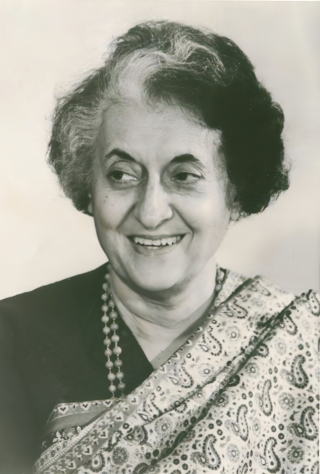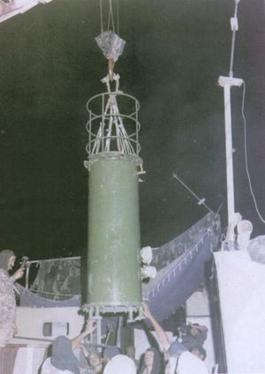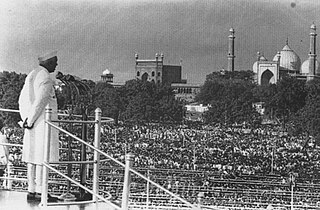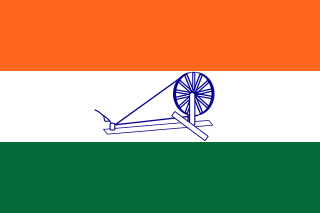
Indira Priyadarshini Gandhi was an Indian politician and stateswoman who served as the third prime minister of India from 1966 to 1977 and from 1980 until her assassination in 1984. She was India's first, and to date only, female prime minister and a central figure of the Indian National Congress. Gandhi was the daughter of Jawaharlal Nehru, the first prime minister of India, and the mother of Rajiv Gandhi, who succeeded her in office as the sixth Indian prime minister. Furthermore, Gandhi's cumulative tenure of 15 years and 350 days makes her the country's second-longest-serving prime minister after her father.

Operation Smiling Buddha or Operation Happy Krishna was the assigned code name of India's first successful nuclear bomb test on 18 May 1974. The bomb was detonated on the army base Pokhran Test Range (PTR), in Rajasthan, by the Indian Army under the supervision of several key Indian generals.

Since the Partition of British India in 1947 and subsequent creation of the dominions of India and Pakistan, the two countries have been involved in a number of wars, conflicts, and military standoffs. A long-running dispute over Kashmir and cross-border terrorism have been the predominant cause of conflict between the two states, with the exception of the Indo-Pakistani War of 1971, which occurred as a direct result of hostilities stemming from the Bangladesh Liberation War in erstwhile East Pakistan.

The Indian National Congress (INC), colloquially the Congress Party but often simply the Congress, is a political party in India with widespread roots. Founded in 1885, it was the first modern nationalist movement to emerge in the British Empire in Asia and Africa. From the late 19th century, and especially after 1920, under the leadership of Mahatma Gandhi, the Congress became the principal leader of the Indian independence movement. The Congress led India to independence from the United Kingdom, and significantly influenced other anti-colonial nationalist movements in the British Empire.

Zulfikar Ali Bhutto was a Pakistani barrister and politician who served as the fourth President from 1971 to 1973, and later as the ninth Prime Minister of Pakistan from 1973 to 1977. His government drafted the Constitution of Pakistan in 1973, which remains in effect. He was the founder of the Pakistan People's Party (PPP) and served as its chairman until his execution. His daughter, Benazir Bhutto later led the Pakistan People's Party (PPP) and was the 11th and 13th Prime Minister of Pakistan; his grandson, Bilawal Bhutto Zardari is the current chairman of the PPP, and is serving as the Foreign Minister of Pakistan.
Durga Prasad Dhar, commonly known as D. P. Dhar (1918–1975), was a Kashmiri politician and an Indian diplomat, who is a considered a chief architect of the Indian intervention in the 1971 Bangladesh Liberation War. Dhar was a close adviser and confidant of Indira Gandhi. He served as the Ambassador of India to the Soviet Union, and as a minister in the Government of Jammu and Kashmir as well as the Government of India.

Terrorism in India, according to the Home Ministry, poses a significant threat to the people of India. Compared to other countries, India faces a wide range of terror groups. Terrorism found in India includes Islamic terrorism, separatist terrorism, and left-wing terrorism India is one of the countries most impacted by terrorism.

The Pokhran-II tests were a series of five nuclear bomb test explosions conducted by India at the Indian Army's Pokhran Test Range in May 1998. It was the second instance of nuclear testing conducted by India; the first test, code-named Smiling Buddha, was conducted in May 1974.

The history of independent India began when the country became an independent nation within the British Commonwealth on 15 August 1947. Direct administration by the British, which began in 1858, affected a political and economic unification of the subcontinent. When British rule came to an end in 1947, the subcontinent was partitioned along religious lines into two separate countries—India, with a majority of Hindus, and Pakistan, with a majority of Muslims. Concurrently the Muslim-majority northwest and east of British India was separated into the Dominion of Pakistan, by the Partition of India. The partition led to a population transfer of more than 10 million people between India and Pakistan and the death of about one million people. Indian National Congress leader Jawaharlal Nehru became the first Prime Minister of India, but the leader most associated with the independence struggle, Mahatma Gandhi, accepted no office. The constitution adopted in 1950 made India a democratic country, and this democracy has been sustained since then. India's sustained democratic freedoms are unique among the world's newly independent states.

Gaj Singh, referred to as Bapji, is an Indian politician who served as a member of the Indian parliament and as Indian High Commissioner to Trinidad and Tobago. He became the titular Maharaja of Jodhpur in 1952.

The Indian National Congress was established when 72 delegates from all over the country met at Bombay in 1885. Prominent delegates included Dadabhai Naoroji, Surendranath Banerjee, Badruddin Tyabji, Pherozeshah Mehta W. C. Bonnerjee, S. Ramaswami Mudaliar, S. Subramania Iyer, and Romesh Chunder Dutt. The Englishman Allan Octavian Hume, a former British civil servant, was one of the founding members of the Indian National Congress.

India–Pakistan relations are the bilateral ties between the Republic of India and the Islamic Republic of Pakistan. The two countries have a complex and largely hostile relationship that is rooted in a multitude of historical and political events, most notably the partition of British India in August 1947; the India–Pakistan border is one of the most militarised international boundaries in the world. Northern India and most of modern-day Pakistan overlap with each other in terms of their common Indo-Aryan demographic, natively speaking a variety of Indo-Aryan languages.

Karan Singh is an Indian politician and philosopher. He is the son of the last ruling Maharaja of the princely state of Jammu and Kashmir, Sir Hari Singh. He was the prince regent of Jammu and Kashmir until 1952. From 1952 to 1965 he was the Sadr-i-Riyasat (President) of the state of Jammu and Kashmir in the Republic of India. He is the chairperson trustee of the Dharmarth Trust of Jammu and Kashmir which maintains 175 temples in north India and works in other areas such as historical preservation.

The Indira–Sheikh Accord signed in 1975 between Kashmiri leader Sheikh Abdullah and then Prime Minister of India Indira Gandhi, decided the terms under which Abdullah would reenter the politics of Kashmir. It allowed Abdullah to become Chief Minister of Jammu and Kashmir again after 22 years and enabled competitive politics in the State.

Sartaj Aziz is a Pakistani economist and a strategist, having previously served as the deputy chairman of the Planning Commission of Pakistan, member of the federal cabinet as the de facto Minister for Foreign Affairs, a Federal Senator as well as the National Security Advisor.
Secession in India typically refers to state secession, which is the withdrawal of one or more states from the Republic of India. Whereas, some have wanted a separate state, union territory or an autonomous administrative division within India. Many separatist movements exist with thousands of members, however, some have low local support and high voter participation in democratic elections. However, at the same time, demanding separate statehood within under the administration of Indian union from an existing state can lead to criminal charges under secession law in India. India is described as a ‘Union of States’ in Article 1 of the Indian constitution I.e indestructible nation of destructible states where a state or Union territory of India can't secede from India by any means.
Longri Ao (1906–1981), also known by name Longritangchetha, was an indigenenous Baptist missionary from the North-Eastern state of India, Nagaland. He was a missionary to the Konyak people and a peacemaker. He is known to have risked his life to restore peace in Nagaland, and to negotiate a ceasefire agreement between the Government of India and underground leaders fighting for Nagaland secession from India.

Gopalaswami Parthasarathy, often known simply as GP, was an Indian journalist, educationist, and diplomat who served as Permanent Representative to the United Nations from August 1965 to December 1968.
Bleed India with a Thousand Cuts is a military doctrine followed by the Pakistani military against India. It consists of waging covert war against India using insurgents at multiple locations. According to scholar Aparna Pande, this view was put forward in various studies by the Pakistani military, particularly in its Staff College, Quetta. Peter Chalk and Christine Fair cite the former director of the Inter-Services Intelligence (ISI) explicating the strategy.

The foreign policy of the Indira Gandhi government was the foreign policy of India between 1967 and 1977 during the Indira Gandhi premiership. It included a focus on security, by fighting militants abroad and strengthening border defenses. On 30 October 1981 at the meeting organised to mark silver jubilee celebration of the School of International Studies, Gandhi said, "A country’s policy is shaped by many forces- its position on the map, and the countries which are its neighbours, the policies they adopt, and the actions they take, as well as its historical experiences in the aggregate and in terms of its particular success or traumas."















